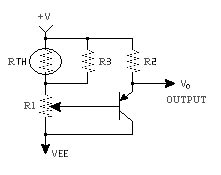LCD Contrast Adjustment and Temperature Compensation
Contrast, or more appropriately, the contrast ratio of a liquid crystal display is the ratio of the light area of a display to the dark area. The contrast ratio changes, when ambient temperature going up or down. For most applications this variation in contrast is tolerable over the “normal” temperature range of 0°C to +50°C. Most Topway LCD modules are available with an extended temperature range option which allows the display to operate from -20°C to +70°C. The changes in contrast are NOT usually tolerable over this wide a range of temperatures, which means a way to adjust the contrast voltage as ambient temperature changes should be provided.
LCD Contrast Adjustment
During product development, A potentiometer is connected to LCD's power supply rails. The wiper of the pot is connected to Vo. The pot is adjusted to obtain optimum LCD appearance. Now you can either leave the potentiometer there, or replace it with a pair of proper resistors. All LCD modules produced by Topway have preset with optimized contrast at room temperature.

LCD Contrast Adjustment with Temp. Compensation
The nature of liquid crystal fluid, contrast versus voltage versus temperature characterstic determines a compensation to the LCD driving voltage may be needed. Especially when the display's working temperature range is wide.
There are different ways to compensation LCD driving voltage, like letting user manually adjust it or product microprocessor supplies proper voltage to the LCD according to ambient temperature's measurement. These are neither practical nor economic.
A common approach to temperature compensation is to provide a circuit shown below to adjust driving voltage automatically.

A thermistor, RTH should reside closely to LCD module to sense environment temperature. Resistor R1 provide the adjustment to select proper initial voltage (or you can use 2 fixed voltage divider resistors). R2 is used as a minimum bias resistor.
Many of Topway's LCD modules have a built-in PWM function, user can easily adjust LCD's contrast as needed.
